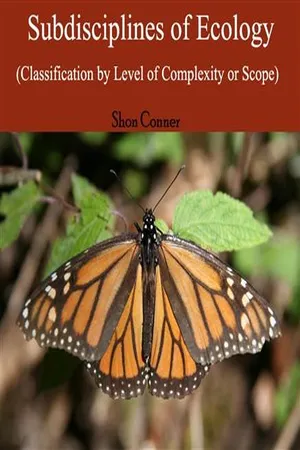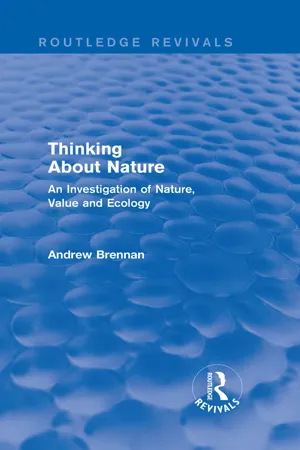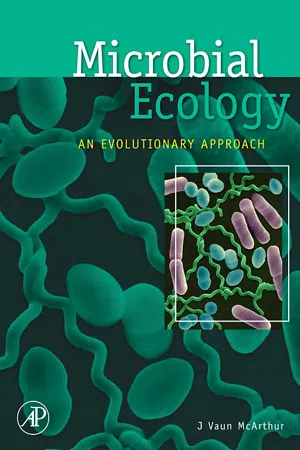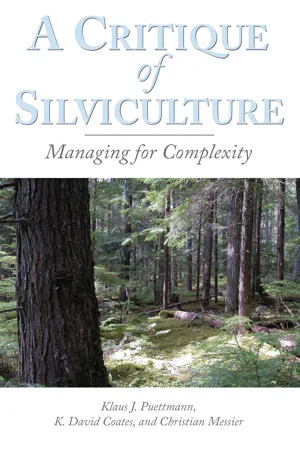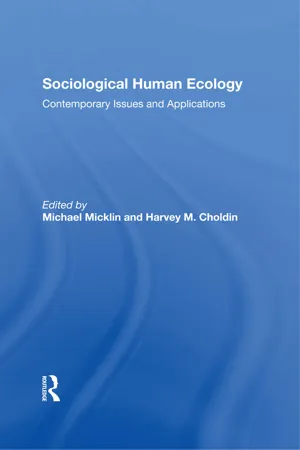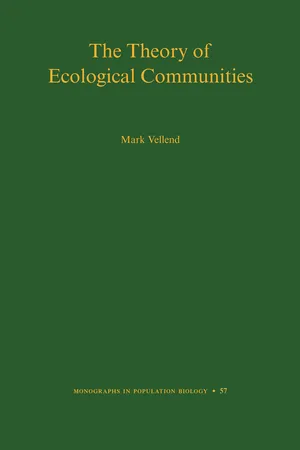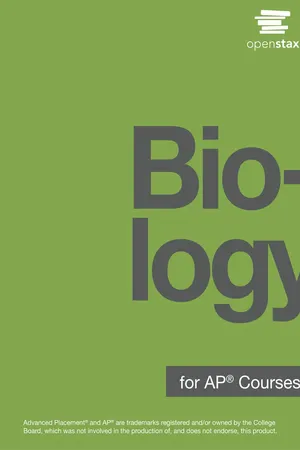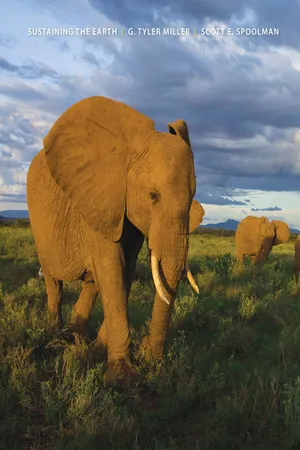Biological Sciences
Community Ecology
Community ecology is the study of the interactions among species within a particular habitat or ecosystem. It focuses on understanding the patterns of species diversity, distribution, and abundance, as well as the processes that influence these patterns. Community ecologists examine how species coexist, compete for resources, and interact with one another, shedding light on the complex web of relationships within ecological communities.
Written by Perlego with AI-assistance
Related key terms
1 of 5
12 Key excerpts on "Community Ecology"
- eBook - ePub
- Laurie Ann Callihan(Author)
- 2013(Publication Date)
- Research & Education Association(Publisher)
CHAPTER 7 Population Biology CHAPTER 7 POPULATION BIOLOGY ECOLOGYEcology is the study of how organisms interact with other organisms and how they influence or are influenced by their physical environment . The word “ecology” is derived from the Greek term oikos (meaning “home” or “place to live”) and ology (meaning “the study of ”), so ecology is a study of organisms in their home. This study has revealed a number of patterns and principles that help us understand how organisms relate to their environment. First, however, it is important to grasp some basic vocabulary used in ecology.The study of ecology centers on the ecosystem. An ecosystem is a group of populations found within a given locality, including the abiotic environment around those populations. A population is the total number of a single species of organism found in a given ecosystem. Typically, there are many populations of different species within a particular ecosystem. The term organism refers to an individual of a particular species. Each species is a distinct group of individuals that are able to interbreed (mate), producing viable offspring. Although species are defined by their ability to reproduce, they are usually described by their morphology (their anatomical features).Populations that interact with each other in a particular ecosystem are collectively termed a community . For instance, a temperate forest community includes pine trees, oaks, shrubs, lichen, mosses, ferns, squirrels, deer, insects, owls, bacteria, fungi, etc.The part of the Earth that includes all living things is called the biosphere . The biosphere also includes the atmosphere (air), the lithosphere (ground), and the hydrosphere (water).A habitat refers to the physical place where a species lives. A species’ habitat must include all the factors that will support its life and reproduction. These factors may be biotic (i.e., living—food source, predators, etc.) and abiotic - No longer available |Learn more
- (Author)
- 2014(Publication Date)
- University Publications(Publisher)
________________________ WORLD TECHNOLOGIES ________________________ Chapter- 10 Community (ecology) Interspecific interactions such as predation are a key aspect of Community Ecology. In ecology, a community is an assemblage of two or more populations of different species occupying the same geographical a rea. The term community has a variety of uses. In its simplest form it refers to groups of organisms in a specific place and/or time, for example, the fish community of Lake Ontario before industrialization. Community ecologists study the interactions between species in communities on many spatial and temporal scales, including the distribution, structure, abundance, demography, and interactions between coexisting populations. The primary focus of Community Ecology is on the interactions between populations as determined by specific genotypic ________________________ WORLD TECHNOLOGIES ________________________ and phenotypic characteristics. Community Ecology has its origin in European plant sociology. Modern Community Ecology examines patterns such as variation in species richness, equitability, productivity and food web structure (see community structure; it also examines processes such as predator-prey population dynamics, succession, and community assembly. On a deeper level the meaning and value of the community concept in ecology is up for debate. Communities have traditionally been understood on a fine scale in terms of local processes constructing (or destructing) an assemblage of species, such as the way climate change is likely to affect the make-up of grass communities. Recently this local community focus has bee n criticised. Robert Ricklefs has argued that it's more useful to think of communities on a regional scale, drawing on evolutionary taxonomy and biogeography, where some species or clades evolve and others go extinct. Interspecific interactions Species interact in various ways: competition, predation, parasitism, mutualism, commensalism, etc. - eBook - PDF
- Singh, Lalan Kumar, Arvind Kumar(Authors)
- 2021(Publication Date)
- Daya Publishing House(Publisher)
Chapter 1 Community Ecology: A Critical Review Arvind Kumar Environmental Science Research Unit, Post Graduate Department of Zoology, S.K.M. University, Dumka – 814 101, Jharkhand, India Introduction Organisms of a particular species form a population, which has characteristics like natality, mortality, age structure, growth, dynamics etc. But when several populations share a common habitat and its resources and interact among themselves, they develop into a biotic community or simply a community. Thus, a community is a longer unit than a population, since it includes more than one species population. In other words, a community is a local association of several population of different species or a naturally occurring assemblage of plants and animals belonging to different species which live in the same environment, are mutually sustaining and interdependent, constitute a biotic community or biocenose. Microorganisms, plants and animal populations sharing a common habitat and interacting among themselves develop into biotic communities. A biotic community has its own characteristics. Animal populations sharing a common habitat and interacting among themselves form an animal community and plant populations of an area form a plant community, but the concept of biotic community includes all populations of living organisms of a common habitat, ranging from a tract of forest to the whole of the forest, from a small pond to a large lake, and so on. The biological potential of each species population determines a tolerance range for environmental conditions. A taxon can tolerate a certain range of environmental condition which is called as its ecological amplitude. The composition of a biotic community in any habitat is dependent upon the This ebook is exclusively for this university only. Cannot be resold/distributed. prevalence of environmental conditions in that habitat and the ecological amplitude of species populations. - eBook - ePub
Thinking about Nature (Routledge Revivals)
An Investigation of Nature, Value and Ecology
- Andrew Brennan(Author)
- 2014(Publication Date)
- Routledge(Publisher)
4 Ecology in Perspective 4.1 Some history Ecology is concerned with species populations as members of communities inhabiting a certain abiotic background in which there may be competition or co-operation. The small number of examples so far given could be multiplied. But to do so would reinforce an impression that should already be obvious. The way organisms fare in what Darwin called the ‘struggle for existence’ will depend on their own characteristics, the characteristics of other organisms around them and the nature of the abiotic context. At levels of organisation above the population, mere may be principles of community structure which explain the distribution of species in a certain area, and the nature of the niches they occupy. One aspect of contemporary ecology not mentioned so far concerns the interactions among very different kinds of species. For example, animal species are on the whole more mobile than plant species. Because bees fly around moderately freely, while the plants they pollinate and feed on are static, we tend to think of bees as utilising plants as resources. But, equally reasonable on a resource model is the notion that bees are resources (pollinators) for plants. So, for example, we could look to see whether certain plant assemblages are organised in such a way as to reduce competition for pollinator service (Armbruster 1986). The examples mentioned so far have involved little dependence on such well known ecological concepts as those of niche, succession, and food chain or food web. These concepts themselves developed as ecology developed from its origins in the study of natural history. Indeed, in 1927 Elton defined ecology as no more man scientific natural history. Nowadays, ecologists would be uncomfortable about accepting such a definition, for it suggests something at once too amateurish and too descriptive - eBook - PDF
Microbial Ecology
An Evolutionary Approach
- J Vaun McArthur(Author)
- 2006(Publication Date)
- Academic Press(Publisher)
For example, studies on small mammals such as mice must include atten-tion to their predators (i.e., birds and other mammals) and to their food (i.e., plants) to understand some of the factors that control the distribution and abundance of the mice. Most researchers sift the environment through a mesh size that captures the organ-isms of interest. Few small mammal researchers examine the herptofauna (i.e., rep-tiles and amphibians) or the annelids (i.e., worms), insects (except those used as food), nematodes, or fungi, or bacteria. Plants may or may not be included. For many ecologists, a community is specific to groups of organisms: plant communities, small mammal communities, or insect communities. A human community is the distribution of humans within a specific geographic area. Within a human community, several sieves can be used to sort the people into groups. Religion, political persuasion, ethnic group, working class, sex, and age are examples of such filters. Within a group, numerous subgroups can form populations, and because of the nature of the filters used, there may be significant overlap between and among groups or populations. If we subdivided the community into males and females and then subdivided those sets into ethnic groups, every individual would be cross-classified into at least two groups and perhaps more, depending on the ethnic-ity of their parents. Community Ecology is the science of groups. Inherent in the study of communities is some estimate of the diversity and abundance of species found within the commu-nity. These measures (i.e., species diversity and abundance) are affected by the scale chosen by the researcher. The actual species diversity of a specific location is deter-mined by the size of the area and the taxonomic resolution desired by the researcher. - eBook - ePub
Insect Ecology
An Ecosystem Approach
- Timothy D. Schowalter(Author)
- 2016(Publication Date)
- Academic Press(Publisher)
Section III Community EcologyIntroduction Chapter 8: Species Interactions Chapter 9: Community Structure Chapter 10: Community DynamicsPassage contains an image
Introduction
Species co-occurring at a site interact to various degrees, both directly and indirectly, in ways that have intrigued ecologists since the earliest times. These interactions regulate population dynamics, thereby affecting community structure, and also control rates of energy and matter fluxes among organisms, thereby affecting ecosystem function. Some organisms engage in close, direct interactions, as consumers and resources, whereas others interact indirectly in ways that affect activity, such as foraging behavior and reproduction. For example, predation on mimics depends on the presence of their models, and herbivores can be affected by their host’s chemical responses to other herbivores. Direct interactions, that is, competition, predation, and symbioses, have been the focus of research on factors controlling community structure and dynamics, but recent studies have demonstrated that indirect interactions also control community organization. Species interactions are the focus of Chapter 8 .A community is composed of the plant, animal, and microbial species occupying a site. Some of these organisms are integral and characteristic components of the community and help define the community type, whereas others occur by chance as a result of dispersal, foraging, or other movement across a landscape or through a watershed. Particular combinations of species distinguish desert, grassland, or forest communities. Different species assemblages are found in turbulent stream versus lake or in eutrophic versus oligotrophic systems. The number of species and their relative abundances define species diversity, an aspect of community structure that is the focus of a number of ecological issues. Chapter 9 - eBook - ePub
A Critique of Silviculture
Managing for Complexity
- Klaus J. Puettmann, K. David Coates, Christian C. Messier(Authors)
- 2012(Publication Date)
- Island Press(Publisher)
3 Ecology Acknowledging Complexity Ecology is a young but well-established discipline in the biological sciences. Ecologists in Europe and North America have a long history of organizing themselves in professional societies. The first meeting of the British Ecological Society was held in 1913 and the Ecological Society of America first met in 1915. Ecology evolved almost directly from the rejection of the traditional descriptive approach to scientific work in biogeography (Harper 1982). Unlike forestry and agriculture, ecology did not develop from the need to address a practical problem. It developed from the desire to understand how species are distributed in the world and how they coexist. Ecology describes patterns in nature and strives to identify the mechanisms underlying those patterns. The objective of this chapter is to review the main developments of the science of ecology, especially those related to the importance of complexity to ecosystem functions and processes, such as adaptability to altered conditions, biodiversity, resiliency, and productivity (Gunderson and Holling 2002; Scherer-Lorenzen et al. 2005; Drever et al. 2006). We further focus on research that has formalized concepts that have resulted in a better understanding of how ecosystems, especially forests, self-organize to produce complex patterns (sensu Levin 2005; Solé and Bascompte 2006). The notion of complexity has always been omnipresent in ecology and has influenced greatly the theory and tools used to study the natural world (Bradbury et al. 1996) - eBook - ePub
Sociological Human Ecology
Contemporary Issues And Applications
- Michael Micklin, Harvey M Choldin(Authors)
- 2019(Publication Date)
- Taylor & Francis(Publisher)
The question of change in ecosystems brings up what is probably the most questionable assumption in the ecological perspective when it is applied to human ecosystems. The idea that ecosystems follow a unilinear path of development, culminating in a “climax community” characterized by stable interdependence, was mentioned earlier. While models of social change based on evolutionary concepts have once again become popular with social scientists (e.g., Sahlins and Service, 1960; Parsons, 1966; Adams, 1975; Lenski, 1979; Lenski and Lenski, 1978) they do not posit specific stages of development and leave as an open question the end-point of the evolutionary process. Indeed, twentieth century trends in relationships between humankind and its environment suggest anything but progression toward a balanced, climax relationship (Catton, 1978).The applicability of ecological concepts for the social sciences is the next issue to be considered. As pointed out earlier, the ecological perspective focuses primarily on populations, environments, and their interrelationships. The concept of a population refers to any aggregate defined in terms of at least one common characteristic, but those of concern to ecologists also involve two additional features: territoriality and interaction. Social scientists study a great diversity of populations, although the most common are groups, organizations, communities, and societies.In contrast, the environment concept is much less developed in the social sciences. A distinction between physical and social environments is common, though much greater attention has been given to the latter. Only in recent years have social scientists given serious attention to the nonsocial environment, but there are exceptions to be found among some disciplinary specialties, e.g., resource economics, physical geography and, not surprisingly, human ecology. Nevertheless, there has been a long-standing recognition that the organization of human populations is, to some extent, a response to environmental constraints and possibilities. - No longer available |Learn more
- Cecie Starr, Christine Evers, Lisa Starr, , Cecie Starr, Christine Evers, Lisa Starr(Authors)
- 2015(Publication Date)
- Cengage Learning EMEA(Publisher)
A description of a plant’s niche would include details of its requirements for soil, water, light, and pollinators. Species interactions also affect community structure. In some cases, the effect is indirect. For example, when songbirds eat caterpillars, the birds indirectly benefit the trees that the caterpillars feed on. Other interactions are direct; the actions of one species helps or harms another. Such direct interactions are the subject of the next section. Figure 17.2 Tropical diversity. Two of the 12 or so fruit-eating pigeon species that live in New Guinea’s tropical rain forests (left). Top, a Victoria crowned pigeon, which is the size of a turkey. Below, the smaller superb crowned fruit pigeon. Left, Donna Hutchins; right, top, © Martin Harvey, Gallo Images/Corbis; bottom, © Len Robinson, Frank Lane Picture Agency/Corbis. Take-Home Message 17.2 What factors shape a community? • Communities vary in their species diversity as a result of nonbiological factors such as differences in incoming sunlight, temperature, and soil quality. • Biological factors such as species requirements for survival and reproduction, as well as interactions with other species, also influence community structure. community All populations of all species in some area. habitat The type of place in which a species lives. niche The role of a species in its community. species diversity The number of species and their relative abundance within a community. Copyright 2016 Cengage Learning. All Rights Reserved. May not be copied, scanned, or duplicated, in whole or in part. Due to electronic rights, some third party content may be suppressed from the eBook and/or eChapter(s). Editorial review has deemed that any suppressed content does not materially affect the overall learning experience. Cengage Learning reserves the right to remove additional content at any time if subsequent rights restrictions require it. - eBook - ePub
- Mark Vellend(Author)
- 2016(Publication Date)
- Princeton University Press(Publisher)
Figure 4.1. The filter model of community assembly. In this hypothetical example, a random subset of species in the regional pool has access to a local site; only species with rounded edges can tolerate the abiotic conditions; and competition leads to the elimination of all but one species of each functional type (shape). The two remaining species can coexist stably given contrasting resource requirements.The debate over whether the pursuit of ecological laws should be a central goal of our science, or whether it should be abandoned, has persisted for a long time (MacArthur 1972, McIntosh 1987, Shrader-Frechette and McCoy 1993, Lawton 1999, Cooper 2003, Simberloff 2004, Scheiner and Willig 2011). Importantly, the terms of the debate typically involve an implicit assumption that processes must be considered in the way I have just described—that is, a general theory of ecological communities must involve factors like climate, disturbance, dispersal, predation, competition, and mutualistic interactions. However, one can think about ecological processes at different levels. For example, the processes that determine changes over space and time in allele frequencies in populations are largely ecological in nature (mutation is the only exception), and as described in the next section, population geneticists have approached things quite differently than ecologists.4.3. THE THEORY OF POPULATION GENETICS: HIGH-LEVEL PROCESSES - eBook - PDF
- Julianne Zedalis, John Eggebrecht(Authors)
- 2018(Publication Date)
- Openstax(Publisher)
Science Practice 5.1 The student can analyze data to identify patterns or relationships. Learning Objective 3.40 The student is able to analyze data that indicate how organisms exchange information in response to internal changes and external cues, and which can change behavior. Essential Knowledge 3.E.1 Individuals can act on information and communicate it to others. Science Practice 1.1 The student can create representations and models of natural or man-made phenomena and systems in the domain. Learning Objective 3.41 The student is able to create a representation that describes how organisms exchange information in response to internal changes and external cues, and which can result in changes in behavior. Chapter 36 | Population and Community Ecology 1637 Essential Knowledge 3.E.1 Individuals can act on information and communicate it to others. Science Practice 7.1 The student can connect phenomena and models across spatial and temporal scales. Learning Objective 3.42 The student is able to describe how organisms exchange information in response to internal changes or environmental cues. Behavioral biology is the study of the biological and evolutionary bases for such changes. The idea that behaviors evolved as a result of the pressures of natural selection is not new. Animal behavior has been studied for decades, by biologists in the science of ethology, by psychologists in the science of comparative psychology, and by scientists of many disciplines in the study of neurobiology. Although there is overlap between these disciplines, scientists in these behavioral fields take different approaches. Comparative psychology is an extension of work done in human and behavioral psychology. Ethology is an extension of genetics, evolution, anatomy, physiology, and other biological disciplines. Still, one cannot study behavioral biology without touching on both comparative psychology and ethology. - eBook - PDF
- G. Miller, Scott Spoolman(Authors)
- 2014(Publication Date)
- Cengage Learning EMEA(Publisher)
4 Community Ecology, Population Ecology, and the Human Population In looking at nature, never forget that every single organic being around us may be said to be striving to increase its numbers. CHARLES DARWIN Key Questions and Concepts 4-1 What roles do species play in an ecosystem? CONCEPT 4-1A Eachspeciesplaysaspecificecological role,calleditsniche. CONCEPT 4-1B Anygivenspeciesmayplayoneor moreoffourkeyroles — native,nonnative,indicator,or keystoneroles — inaparticularecosystem. 4-2 How do species interact? CONCEPT 4-2 Fivetypesofspeciesinteractions— interspecificcompetition,predation,parasitism,mutualism, andcommensalism—affecttheresourceuseand populationsizesofthespeciesinanecosystem. 4-3 How do communities and ecosystems respond to changing environmental conditions? CONCEPT 4-3 Thestructureandspeciescomposition ofcommunitiesandecosystemschangeinresponseto changingenvironmentalconditionsthroughaprocess calledecologicalsuccession. 4-4 What limits the growth of populations? CONCEPT 4-4 Nopopulationcancontinuetogrow indefinitelybecauseoflimitationsonresourcesand becauseofcompetitionamongspeciesforthoseresources. 4-5 What factors influence the size of the human population? CONCEPT 4-5A Populationsizeincreasesbecauseof birthsandimmigrationanddecreasesthroughdeathsand emigration. CONCEPT 4-5B Theaveragenumberofchildrenborn towomeninapopulation( total fertility rate )isthekey factorthatdeterminespopulationsize. CONCEPT 4-5C Thenumbersofmalesandfemalesin young,middle,andolderagegroupsdeterminehowfasta populationgrowsordeclines. 4-6 How can we slow human population growth? CONCEPT 4-6 Wecanslowhumanpopulationgrowth byreducingpoverty,elevatingthestatusofwomen,and encouragingfamilyplanning.
Index pages curate the most relevant extracts from our library of academic textbooks. They’ve been created using an in-house natural language model (NLM), each adding context and meaning to key research topics.

